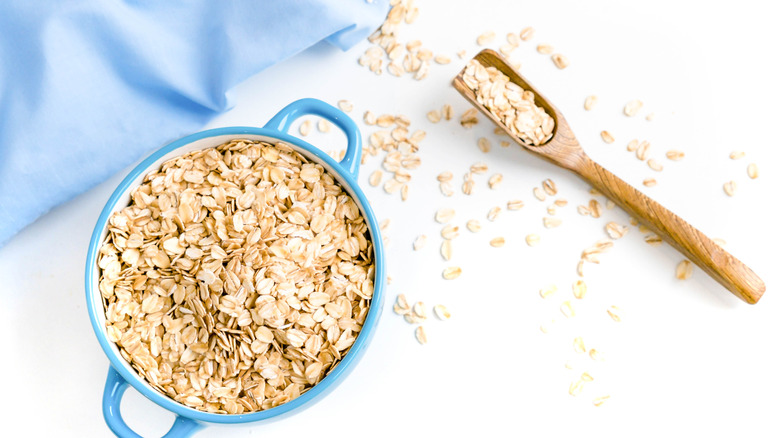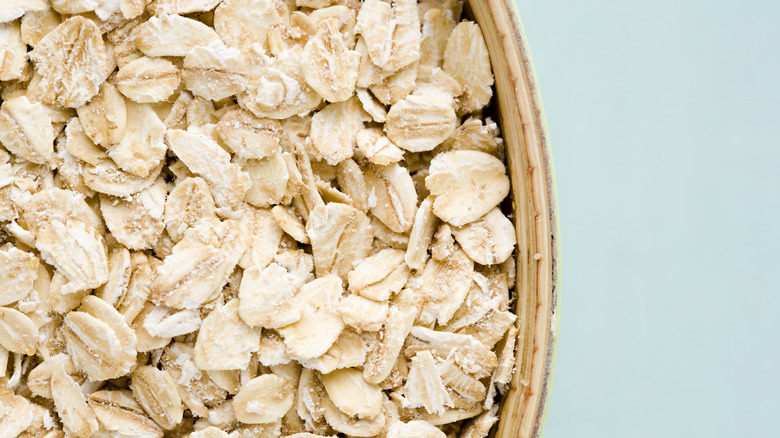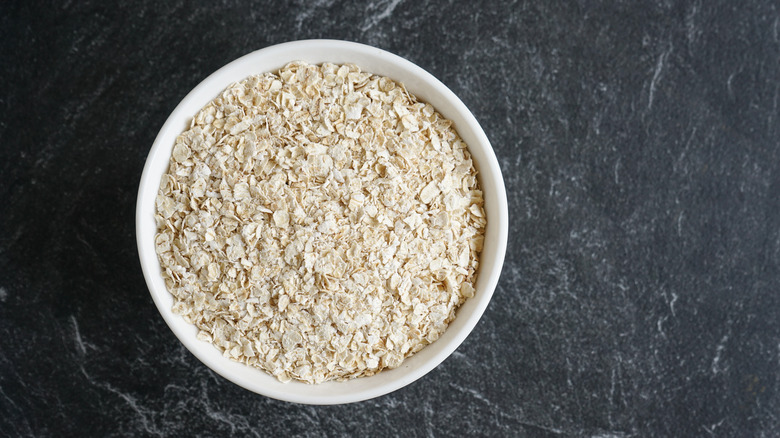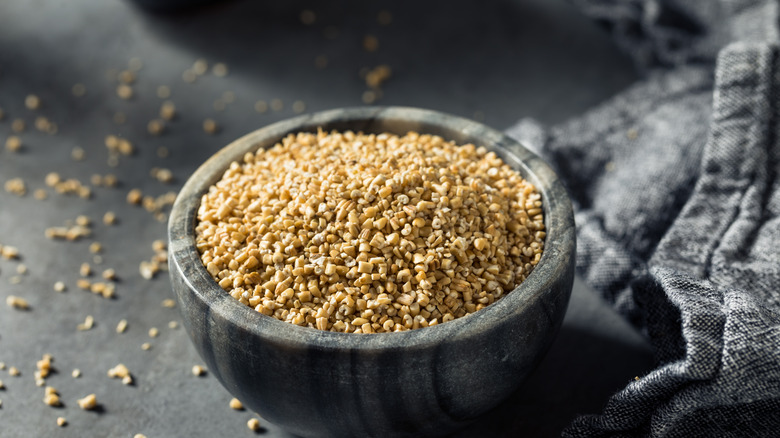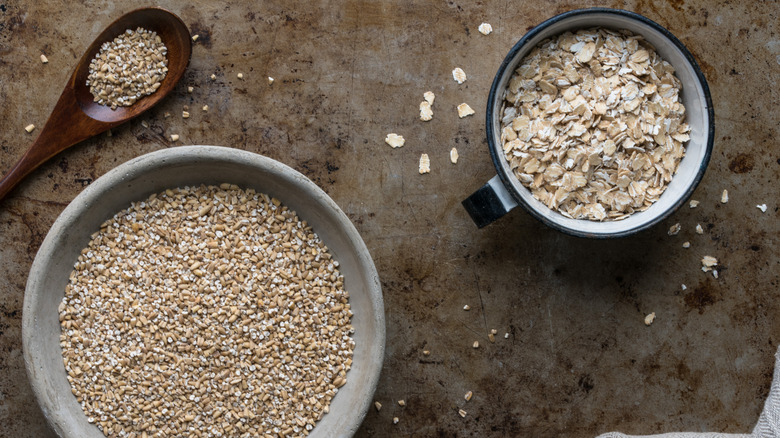How Rolled Oats Differ From Instant And Steel-Cut Varieties
A comforting hot bowl of oatmeal or a grab-and-go jar of overnight oats are tried-and-true breakfast classics: filling, nutritious, and convenient ways to start the day. When choosing which type of oats to use, there are a multitude of options ranging from instant to rolled to steel-cut. Though all start out the same — as a grain that's actually the edible seed portion of oat grass — if you've ever peered down at the seemingly endless array of packages and canisters at the grocery store, you know that not all options are created equal. And that's due to the differing levels of processing oats go through.
Are you confused by the myriad of options or wondering which type is best for your breakfast? Consider this your one-stop guide to the differences between the three major types of oats on grocery store shelves: rolled oats, instant, and steel-cut. After reading this, you'll know which to choose.
What are rolled oats?
We'd bet that if you think of your basic, traditional bowl of oats with brown sugar and cinnamon, the rolled type is what you're picturing. Oats have been consumed by people since just about the beginning of humanity — with research telling us that ancient hunters and gatherers were eating them a whopping 32,000 years ago. Their popularity has essentially never waned, with the Ancient Romans enjoying them and Civil War soldiers relying on the grain as a stick-to-your-ribs staple.
Often sold in a cardboard canister or in the bulk bins of health food stores, where you can buy them by weight, rolled oats (or old-fashioned oats as they're also called) are minimally processed. During manufacturing, the oats are steamed and rolled out flat. This changes the oat from its original kernel shape into a flat but thick flake, meaning rolled oats require a slightly longer cooking time than the instant variety, around 5-10 minutes if you're cooking in the microwave or on the stovetop in water or milk. If you're making oatmeal raisin cookies or a traditional bowl of oatmeal, reach for these as your go-to pick.
What are instant oats?
Known for their quick cooking time and often sold in ready-to-microwave containers or pouches, instant oats are the more convenient, grab-and-go little cousin to old-fashioned or rolled oats. This is thanks to the fact that they've been put through a more advanced level of processing, undergoing a pre-cooking step and getting rolled into a thinner, smaller flake. Quaker, the popular brand we all know and likely have in our kitchens, first introduced this type of breakfast porridge back in 1966 and it's been a mainstay on grocery stores aisles and in pantries ever since.
This lighter, less bulky oat cooks up nearly instantly, hence the name. If you're rushing to get out the door and need a quick power breakfast, nuke them for a mere minute or two, or simply add to a bowl and pour hot water over top. In less time than it takes to put your shoes on, they'll have absorbed the liquid and be ready for any toppings or to be enjoyed as is.
What are steel-cut oats?
Of the main three varities, steel-cut are the least-processed variety and maintain more of their original "off-the-plant" look and shape. If you've never seen them before and are used to the other two styles, you may not even recognize them at first as oats, as the grains aren't the typical flat flake but look more like a tiny, nubby corn kernel.
Steel-cut oats are cut into small pieces with a sharp blade — instead of being steamed or rolled. Because of the lack of processing, steel-cut oats require a longer cooking time – typically around 15-30 minutes on the stovetop. Or leave them overnight in a slow cooker for convenience and wake up to perfect creamy porridge ready to eat. It's not only their appearance that's different from other types oats, but also their taste and texture. If you're looking for a more rustic, hearty, breakfast with a chewier mouthfeel, go for steel-cut.
Rolled and steel-cut oats have a more substantial, hefty texture
Choose which type of oat to use based on the amount of time you have or the desired taste you're after in a recipe. Because they're thinnest and most delicate of the three, a bowl of instant oats will have a finer, softer texture — which can be a plus or a minus depending on what you're after. If you prefer a heartier, chewier texture and bite, rolled oats might be your go-to. And certainly in recipes, be it for muesli, granola, or cookies, you'll want the heftier flake, so stay away from instant.
Steel-cut oats are not only visually granier and coarser, but when cooked have a distinctly nutty taste and chewy texture all their own. Another difference? They keep well for days in the fridge. A pot of cooked steel-cut porridge keeps beautifully in the fridge for breakfasts all week.
Whichever you prefer, all three can be seasoned according to your liking — sprinkle with brown sugar, toss in fruit, melt a slab of butter overtop, or even use them in savory dishes, similar to a polenta or risotto.
In terms of nutrition, all oats are virtually identical
Despite their physical differences and varying degrees of processing, the great news is that all forms of oatmeal, whether you reach for a scoop of rolled, instant, or steel-cut, pack a punch in terms of nutrition. With all this talk of processing, which normally has a negative connotation in the world of nutrition, you might think the processing degrades the nutritional value of rolled or instant oats. Luckily, the addition of moisture and heat (AKA steaming and rolling) changes the final shape but doesn't actually remove their nutritional goodness.
Whichever form you choose, you'll be getting significant servings of heart-healthy fiber, energy-sustaining carbs, and antioxidants. (via Medical News Today). The difference in terms of healthiness comes from any added flavors or sweeteners. Instant oats particular tend to be sold in a multitude of flavors. Be sure to check out the nutrition label and avoid those with tons of extra sugar or artificial add-ins for the healthiest option.
